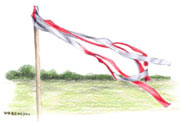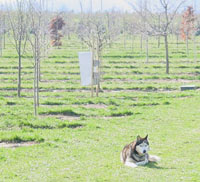Deterrents
Deterrents include scare techniques, the electronic deer repellent, and dogs. Scare techniques are best used for short-term control of deer damage because deer can become habituated to them over time. Deterrent techniques can provide temporary relief of deer damage and should be used with other deer management techniques for best results. Dogs used properly can provide long-term assistance. Deterrents are most effective at the onset of deer damage, before significant damage has occurred.
Scare Devices
Most people picture a motionless scarecrow when they think of a scare device. Modern technology has helped create scare devices that incorporate motion, noise and even electric shock, to be more effective at deterring deer from causing damage. Scare devices can be used to frighten deer from yards, crops, and gardens. Scare devices are most effective when used as soon as damage is detected. These devices can be categorized as either auditory or visual deterrents, depending on how they work. Discretion should be used when employing scare devices. Some devices may be practical for use in rural areas, but may have limited use in suburban settings because they may violate noise ordinances and or may disturb neighbors.
Scare devices can be effective at deterring deer damage, but, because of their adaptable nature, deer can learn to overcome their fear of some scare devices over time. Field trials of various scare devices indicated that deer can become habituated to them after a week of exposure to them. Trials of various scare devices have produced variable results. No definitive studies have evaluated scare devices based on their effectiveness. Consumers should question manufacturers claims. Judgments should be based on testimonials and personal experiences with these products.
A combination of visual and auditory deterrents may be more effective than a single deterrent by itself. For the best results, try a combination of methods to prevent deer from getting used to any one technique. Deer are very adaptable, and can overcome their fear of some scare devices, if they learn that the device presents no real danger. Moving scare devices around, imparting movement to the device, and using repellents in conjunction with scare devices can help improve their effectiveness.
 Auditory Deterrents
Auditory Deterrents
Auditory deterrents can repel deer with their noise, and include noisemakers like gas or propane exploders, whistles, and ultrasonic devices. Gas or propane exploders produce loud, banging noises, which frighten deer away, and have been used to help protect orchards, row crops and truck crops. The most effective exploders detonate at random intervals and / or rotate the direction of their blast to prevent deer from getting used to them. Most auditory deterrents should not be used in suburban or residential areas out of consideration for neighbors - their use should be restricted to rural areas where noise is not a problem.
A radio, activated by a motion detector can also scare off deer. Pie pans or metal cans suspended by strings make noise when they rattle in the wind, and have also been used to deter damage. Motion activated ultrasonic noisemakers scare deer using high-frequency sounds which are inaudible to humans, and don’t violate noise ordinances. Field trials of some of these products showed that they were effective at deterring deer damage initially, but over time, deer became habituated to the sounds they emitted.
Auditory deterrents may be useful in temporarily scaring deer, but may need to be combined with visual deterrents and/or repellents to be effective at deterring persistent deer.
 Visual Deterrents
Visual Deterrents
Visual deterrents include scarecrows, flashing or strobe lights, helium-filled Mylar and “Scare-eye” balloons, Mylar tape and flagging that moves with the wind, and motion activated water sprayers.
Scarecrows work on the principle that deer fear humans, but may lose their effectiveness where deer are accustomed to seeing people. Odor-based repellents or motion can be added to scarecrows to increase their effectiveness.
Visual deterrents that move may be more effective at deterring deer, as deer readily detect and react to movement. Helium-filled “Scare-eye” or Mylar balloons, flagging and Mylar tape that move when the wind blows, have also been used to deter deer damage. Mylar is a shiny plastic material that reflects light and makes noise when the wind blows across it. It can be hung from stakes or plants like streamers to scare deer. Mylar tape twisted into a spiral, and suspended between posts, makes a buzzing sound when the wind blows over it, which can help deter deer.
Infrared motion sensors and/or timers can be used to trigger scare devices, which can scare away deer. Flashing and strobe lights, and water sprayers or sprinklers activated by motion sensors, or set on timers, can also deter deer. Motion-activated water sprayers, triggered by infrared or motion sensors, can prevent deer from getting used to them, and can repel deer. The Smart Crow Motion-Activated Sprinkler, Contac Scarecrow Motion Detector Sprinkler and Spray Away Motion Activated Water Repellent are some commercially available sprinklers designed specifically to ward off deer and other nuisance animals.
Remember that auditory deterrents combined with visual deterrents and / or repellents may be more effective than any one type of deterrent used alone.
Electronic Deer Repellent
The Electronic Deer Repellent by the Woodstream Corporation, is a scare device that works on the same principle as the baited deer fence. It employs an attractant, which encourages deer to touch it, and then administers a harmless electric shock to the deer’s nose or mouth. The shock conditions deer to avoid the area, which prevents them from re-visiting and causing damage. This battery-powered device works similarly to the baited deer fence, only without the fence, and can be placed among flowers and shrubbery, or around gardens. It is less invasive and more appealing than electric fencing. Reports suggest results similar to the baited electric fence, without the visual detraction that the fence creates.
 Dogs As A Deterrent
Dogs As A Deterrent
Dogs can be used as a deterrent to discourage deer from feeding on some crops. A method sometimes employed is to tether a dog on a rope near the plants needing protection. The dog should scare away deer with its barking. It is important that the dog be energetic and willing to bark at the deer. Deer are adaptable and can learn to keep just out of the dog’s reach or may tolerate the dog's barking. This technique can be useful in protecting small areas
An extension of this method is known as the Off Limits Crop Protection System. This system uses trained dogs to keep deer out of an area. The area to be protected is circled by a buried electric cable (invisible fence). The free-roaming dogs are fitted with a radio collar that emits an electric shock whenever the dog ventures near the perimeter of a buried cable. This “wireless fence” system trains the dogs to learn the boundaries of the area to be protected, and allows the dogs to move unrestricted within the area contained by the cable. This system has proven effective at reducing deer damage to larger areas like orchards and nurseries, and can be modified to protect landscaping around the home. An active breed of dog that is willing to chase deer should be used in order for this system to be effective. This system could be adapted for residential areas where deer damage to landscaping is a problem.